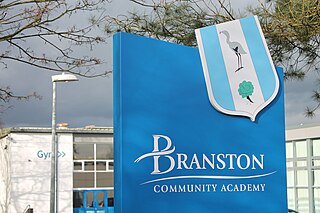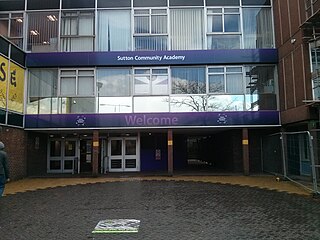
Skegness is a seaside town and civil parish in the East Lindsey District of Lincolnshire, England. On the Lincolnshire coast of the North Sea, the town is 43 miles (69 km) east of Lincoln and 22 miles (35 km) north-east of Boston. With a population of 21,128 as of 2021, it is the largest settlement in East Lindsey. It incorporates Winthorpe and Seacroft, and forms a larger built-up area with the resorts of Ingoldmells and Chapel St Leonards to the north. The town is on the A52 and A158 roads, connecting it with Boston and the East Midlands, and Lincoln respectively. Skegness railway station is on the Nottingham to Skegness line.

Skegness Grammar School is a coeducational grammar school and sixth form with academy status, located in Skegness, Lincolnshire, England.

Branston Community Academy, is a secondary school for 11- to 18-year-old students on Station Road in Branston, Lincolnshire, England.
The West Bridgford School is a co-educational comprehensive school with academy status in West Bridgford, Nottinghamshire, England.
Lincolnshire is one of the few counties within the UK that still uses the eleven-plus to decide who may attend grammar school, in common with Buckinghamshire and Kent.

Sutton Community Academy is a coeducational secondary school and sixth form with academy status, located in Sutton-in-Ashfield, Nottinghamshire, England.
The Vale Academy is a co-educational secondary school with academy status on Atherton Way in the market town of Brigg, North Lincolnshire, England.

ThePriory City of Lincoln Academy is a co-educational secondary academy and sixth form in Lincoln, Lincolnshire, England. It is a member of The Priory Federation of Academies and leads the government's School Games Organiser programme. It is also a specialist school in sports and health, exercising a partially selective intake in the former.

Franklin Sixth Form College is a sixth form college on Chelmsford Avenue in Grimsby, North East Lincolnshire, England, serving more than 2,700 students, including adult learners.
The Humphrey Perkins School is a secondary school with academy status which was founded in 1717 in Barrow upon Soar, Leicestershire, in England.
William Farr School, formally William Farr C of E Comprehensive School, is a Church of England academy school for 11 to 18-year-olds i. the village of Dunholme, Lincolnshire but officially in Welton, Lincolnshire, England, 8 km (5 mi) north-east of Lincoln, near the A46. Despite officially being a part of Welton, most of the school grounds are in the civil parish of Dunholme.

Barnes Wallis Academy is a coeducational secondary school located in the village of Tattershall in Lincolnshire, England.
The Giles Academy is a mixed secondary school located in Old Leake in the English county of Lincolnshire.
The Priory Witham Academy is a mixed all-through school and sixth form located in Lincoln in the English county of Lincolnshire. The school educates pupils aged 3 to 18.
William Lovell Church of England Academy is a coeducational Church of England secondary school with academy status, located in Stickney in the English county of Lincolnshire.

The Axholme Academy is a mixed secondary school located in Crowle, North Lincolnshire, England.
Kirton Academy is a mixed secondary school located in Kirton in Lindsey, North Lincolnshire, England.
St Bede's Catholic Voluntary Academy is a mixed Roman Catholic secondary school located in Scunthorpe, North Lincolnshire, England.
Neston High School is a coeducational secondary school and sixth form with academy status located in Neston on the Wirral Peninsula, in the English county of Cheshire.
Coteland's School Ruskington was a secondary-level community school in the village of Ruskington, Lincolnshire, accommodating pupils aged 11–16 through years 7 to 11. It formally opened as Ruskington Secondary Modern School in 1957, although teaching had begun the previous year. It federated with St George's College of Technology in nearby Sleaford in 2007, and then closed at the end of 2009 to allow the schools to merge into St George's Academy. The buildings and grounds were significantly redeveloped in 2012–2015 to serve as a satellite school for the academy.










